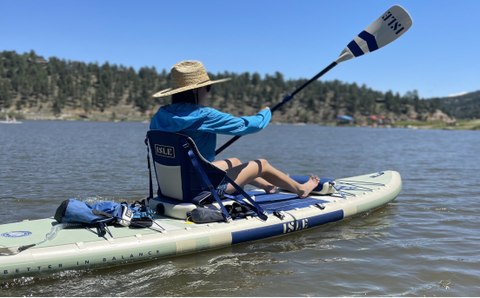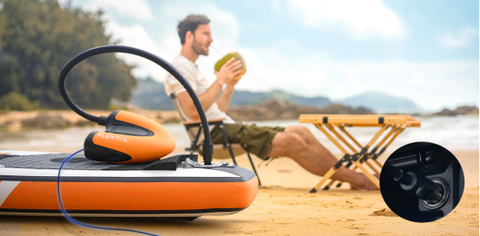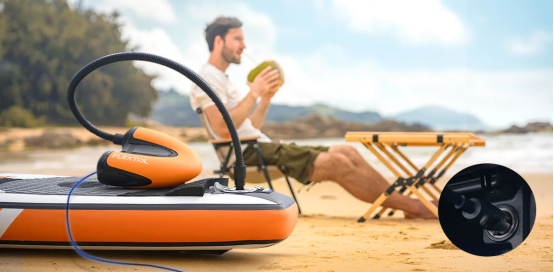Paddle boarding has surged in popularity as a versatile water sport, offering a blend of adventure, relaxation, and fitness benefits. Central to this experience is the paddle board pump, a seemingly simple yet crucial tool that ensures your board is inflated to perfection, directly impacting performance and safety. This blog will dive into the various types of paddle board pumps, how to use them and how to select the best one for your needs, ensuring you get the most out of your paddle boarding adventures.

Paddle board pumps overview
Paddle board pumps play a crucial role in preparing stand-up paddleboards (SUPs) for use by inflating them to the necessary pressure for buoyancy and optimal performance on the water. Available in a range of styles, these pumps cater to the diverse requirements and preferences of users, ensuring there's a suitable option for every paddler.
Having a reliable paddle board pump is paramount. It not only ensures your board reaches the optimal pressure for stability and performance, but also significantly impacts your overall experience, reducing setup time and effort, so you can enjoy more time on the water.
Types of paddle board pumps
In the world of paddle boarding, having the right pump can make a significant difference in your preparation time and overall experience on the water. Understanding the nuances of different types of paddle board pumps—manual, electric, and battery-operated—is essential for selecting the one that best suits your needs. Each type offers unique features, benefits, and considerations. Let's delve into the specifics of each to help you make an informed decision.
-
Manual pumps
Manual pumps require physical effort from the user. They operate through a hand or foot pumping action that pushes air into the paddle board until it reaches the desired pressure.
Pros and cons:
- Pros: Cost-effective, portable, and do not require a power source.
- Cons: Time-consuming and physically demanding, especially for larger boards or higher pressures.
-
Electric pumps
Electric pumps are powered by an electric motor, which automates the inflation process. They typically connect to a car's 12V outlet or a standard electrical outlet.
Advantages over manual pumps:
- Efficiency: Significantly faster and requires minimal physical effort.
- Consistency: Provides consistent pressure, reducing the risk of under- or over-inflation.
Considerations for power sources:
- Dependence on access to electricity or a vehicle for power.
- Some models may drain car batteries if the engine isn't running.
-
Battery-operated pumps
With a battery, these pumps combine the convenience of electric pumps with the portability of manual ones, making them ideal for remote locations.
Battery life and charging options:
- Battery Life: Varies widely among models; some can inflate multiple boards on a single charge.
- Charging Options: Typically include USB or car charger options, providing flexibility in how and where you can recharge them.
Choosing among manual, electric, and battery-operated pumps depends on your specific needs, such as the frequency of use, convenience, budget, and access to power sources. Each type has its advantages, whether you prioritize ease of use, affordability, or portability.

How to use a SUP pump
Inflating and deflating your paddle board correctly is crucial for both the longevity of your board and your safety on the water. Whether you’re using a manual, electric, or battery-operated SUP pump, the process should be approached with care and attention to detail. Here's a comprehensive guide on how to efficiently and safely manage your paddle board's inflation and deflation processes.
How to inflate a paddle board with a pump
- Unroll and Flatten Your Board: Start by unrolling your paddle board on a flat, clean surface to avoid punctures.
- Attach the Pump: Connect your SUP pump to the board's valve. Ensure the valve pin is in the closed position (upright) to prevent air from escaping.
- Start Pumping:
For manual SUP pumps, use a consistent rhythm and switch from double action (pumping air on both up and down strokes) to single action (pumping air only on down strokes) as resistance increases.
For electric or battery-operated SUP pumps, turn on the pump and monitor the pressure.
- Reach the Recommended PSI: Inflate the board to the manufacturer’s recommended PSI, usually between 12 to 15 PSI, for optimal performance and stability.
- Disconnect the Pump: Once the desired PSI is reached, quickly close the valve cap to prevent air from escaping as you disconnect the pump.
Safety tips and best practices
- Inspect for Damage: Always examine both your board and pump for potential damage before starting the inflation process to prevent any accidents.
- Prevent Over-Inflation: Ensure you do not inflate the board beyond its recommended PSI level to avoid causing damage.
- Utilize a Pressure Gauge: Make it a practice to use a pump equipped with a pressure gauge, guaranteeing that your board is inflated to precise and safe pressure.
How to deflate your paddle board properly
- Open the Valve: Press down and twist the valve pin to the open position to let air out.
- Roll the Board: Start from the nose, roll the board towards the valve to push air out.
- Close the Valve: Once fully deflated and rolled up, close the valve to keep moisture out during storage.
By following these steps and adhering to safety guidelines, you can ensure your paddle boarding adventures start smoothly and your equipment remains in top condition.

How to choose the right paddle board pump
Selecting the right paddle board pump is as crucial as choosing the board itself. The right pump can save you time, energy, and ensure your board performs at its best. When navigating through the options, consider the pump type, PSI capacity, portability, and price. Here’s how these factors play into your decision and some recommendations to suit different paddling needs.
What you should consider
- Pump Type: Your choice between manual, electric, and battery-operated pumps will depend on your preference for convenience versus effort and accessibility to power sources.
- PSI Capacity: Ensure the pump can reach the required PSI for your board without strain. Most boards operate best between 12 to 15 PSI.
- Portability: If you often travel or hike to your paddling locations, a lightweight and compact pump is essential.
- Price: Manual pumps are generally cheaper, but investing in a high-quality electric or battery-operated pump can be worthwhile for frequent paddlers.
Recommendations for different needs
- Casual Use: A manual pump may suffice if you paddle occasionally and close to home, where the effort and time taken to inflate your board manually are minimal concerns.
- Frequent Travelers: Battery-operated pumps offer the best balance between portability and ease of use, ideal for those who often find themselves inflating their board in remote locations.
- Heavy-Duty Use: For those paddling regularly or managing multiple boards, an electric pump with a high PSI capacity and reliable durability will save time and energy.
Tips for maintenance and longevity
- Regular Cleaning: Dust and sand can wear down the pump’s mechanisms. Clean your pump regularly with a dry cloth.
- Lubrication: Occasionally lubricate moving parts according to the manufacturer’s instructions to keep the pump action smooth.
- Storage: Store your pump in a cool, dry place out of direct sunlight to prevent wear and tear on hoses and seals.
- Check for Wear: Regularly inspect your pump for signs of wear and tear, especially the hose and connectors, to prevent leaks or failures.
By carefully considering these factors and following maintenance tips, you can choose a paddle board pump that will serve you well for many seasons, enhancing your overall paddle boarding experience.
Must-have accessories for your paddle board pump
To maximize the functionality and convenience of your paddle board pump, there are several must-have accessories that can enhance your experience:
- Pressure Gauges: Essential for monitoring the inflation level of your paddle board, ensuring you reach the optimal PSI without over or under-inflating.
- Adapters for Different Types of Paddle Boards: Having a set of adapters is crucial for compatibility with various paddle board valves, making your pump versatile and suitable for different brands and types.
- Carrying Cases: A durable carrying case not only makes transporting your pump easy and convenient but also protects it from damage and the elements, keeping all accessories organized and accessible.
These accessories significantly contribute to a hassle-free paddle boarding experience, ensuring your equipment is always ready and in top condition.

Troubleshooting common paddle board pump issues
Encountering issues with your paddle board pump can be frustrating, especially when you're eager to get on the water. Understanding how to troubleshoot common problems can save you time and extend the life of your pump. Here’s how to address leaks, overheating, and fitting issues, along with advice on when it’s time to repair or replace your pump.
1. Pump leaking
Check all connections and hoses for tightness. Leaks often occur at the junction where the hose connects to the pump or the board. Replacing worn or damaged O-rings and ensuring a secure fit can often resolve this issue.
2. Pump overheating
Electric pumps are prone to overheating with excessive use. To prevent this, allow your pump to cool down after inflating each board, and avoid using it in direct sunlight for prolonged periods. If overheating persists, inspect the air vents for blockages that could be restricting airflow.
3. Fitting issues
Not all pump nozzles fit every paddle board valve, leading to air leakage during inflation. Utilizing the correct adapter for your board’s valve type is crucial. If your pump didn’t come with a needed adapter, they can often be purchased separately.
4. When to repair vs. when to replace
- Repair: Minor issues like leaks, loose connections, or easily replaceable parts (hoses, nozzles, O-rings) typically warrant a repair. If your pump is under warranty, contacting the manufacturer for repair or replacement parts is advisable.
- Replace: If your pump has significant damage, such as a burnt-out motor (in electric pumps), cracked casing, or repeated overheating issues that can’t be resolved with basic troubleshooting, it’s time to consider a replacement. Additionally, if the cost of repair approaches or exceeds the price of a new pump, purchasing a new one might be more economical.
Identifying and resolving common paddle board pump issues can be straightforward with a bit of knowledge and the right approach. Knowing when to repair your pump and when to replace it ensures you always have reliable equipment for your paddle boarding adventures.
Summing up
Choosing the right paddle board pump is fundamental to your paddle boarding experience. The right pump not only ensures your board is inflated to the perfect pressure for optimal performance but also saves you time and effort, allowing you to enjoy the water sooner. Investing in a quality pump—be it manual, electric, or battery-operated—is an investment in your paddle boarding future. A reliable, efficient pump enhances your experience, making every trip to the water smoother, more enjoyable, and hassle-free.
 EN
EN JA
JA






